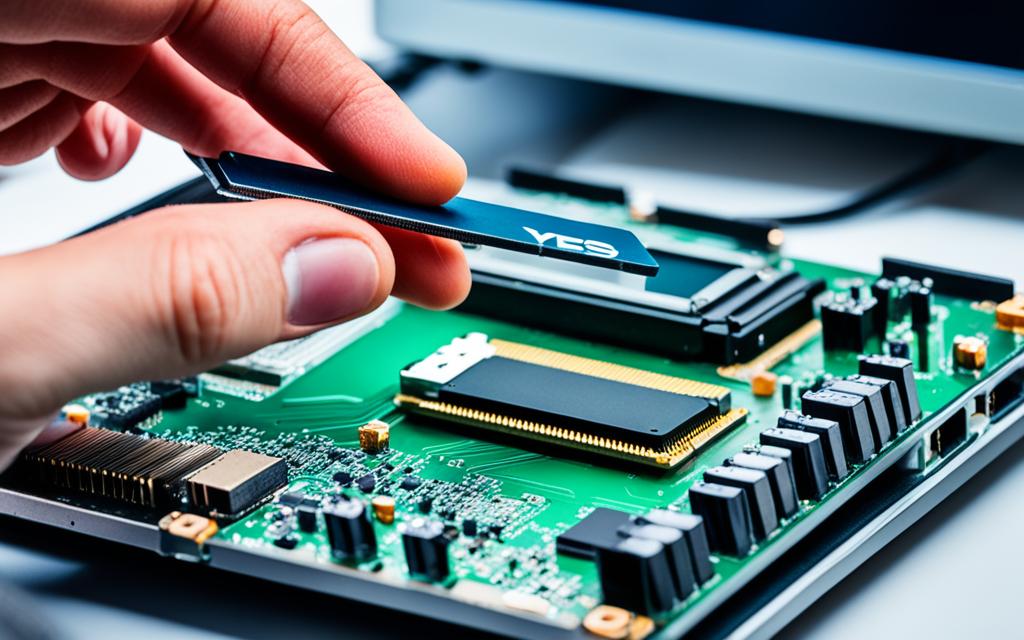Table of Contents
Starting with a new SSD means you need to know about formatting. Though many SSDs come ready to use, formatting is still key. It makes sure your drive works well with your system and boosts its performance.
As SSDs get more popular, especially at home, knowing how to format them is key. Formatting helps for things like putting in a new operating system or setting up for Windows, Mac, or Linux. It’s the base for a good start with your new SSD123.
Key Takeaways
- Formatting a new SSD is typically essential for compatibility with various operating systems.
- Correct formatting can enhance the SSD’s lifespan and performance.
- Understanding specific requirements for different file systems is critical for effective SSD setup.
- Utilising tools like Disk Management and EaseUS Partition Master streamlines the formatting process.
- Backing up data is crucial before engaging in any formatting operation.
- A quick format is recommended to preserve the life of your SSD.
The Importance of Formatting a New SSD
Setting up a new Solid State Drive (SSD) requires understanding its special SSD functionality. SSDs use NAND flash memory, which allows for quicker access times and better durability than HDDs. A proper formatting process is needed to make the most of their features. It sets up the right file system for the operating system, vital for good data handling and improved performance.
Understanding SSD Functionality
SSDs have become massively popular for their speed and dependability. The way they’re formatted is key to this success, making them work well with Windows, Mac, and Linux. The choice of file system options for formatting shows their flexibility, crucial for today’s computing3.
Why Initial Formatting is Beneficial
First-time formatting brings many benefits of SSD formatting. It turns on important features like TRIM, which properly manages data. This boosts SSD performance enhancement over time. By choosing a Quick Format, users can cut down on the wear and tear on the SSD2. Making sure you have the right file system and allocation unit size is important to avoid issues, showing the need for careful choice in formatting settings2.
Tools like EaseUS Partition Master offer wide-ranging options for disk management, including custom formatting choices3.
Do You Have to Format a New SSD?
Formatting an SSD is often seen as a crucial step before you use it. It makes the drive clean, just like it was when new. While it’s not always necessary, it’s important to know when you should format your SSD.
Factors to Consider Before String
Before you decide to format your SSD, think about the operating system SSD requirements. Different systems need different file formats. Some common formats are FAT32, NTFS, exFAT, APFS, and Ext4. FAT32 works with many systems, while NTFS is great for Microsoft systems and big files. Mac users often go for APFS, especially with MacOS 10.13 or newer. Linux fans prefer Ext4. Knowing these can help you decide when to format your SSD. Choosing the right format is key, especially if your SSD already has data on it.
Operating System Requirements
The operating system you use heavily influences how you should format your SSD. For example, Windows usually works best with NTFS or exFAT for peak performance. If you’re installing Windows 10 or another system, format it correctly first. You can use tools like Disk Management for a quick job. EaseUS Partition Master is good for different Windows versions. It makes formatting smoother. Lastly, turning on TRIM support keeps your SSD working well and managing data efficiently423.
When Should You Format Your SSD?
Knowing when to format your SSD can really help your device work better and last longer. It’s important to format it before putting on a new operating system. This makes sure the system can work well with the drive. Getting this right helps everything run smoothly when you’re setting up.
Pre-installation Considerations
Before you start installing, think about formatting your new SSD. This is key for new installations. It clears out old data, making your SSD ready for use. This step also ensures the SSD works effectively from the start.
Formatting for Reuse and Repurposing
When you’re using an SSD from another device, reformatting is essential. It removes old data for new installations. Secure formatting methods make this process easier. They erase personal data safely. This is crucial when giving the SSD to someone else or moving it to a new system. Always secure erase before selling or donating your drive. This keeps your data safe and gives the new user a blank start.
| Formatting Benefits | Details |
|---|---|
| Enhances Performance | Fresh formatting ensures that the SSD can operate at optimal speeds. |
| Data Security | Reformatting eliminates previously stored sensitive information. |
| Compatibility | Proper formatting aligns with varied operating systems for seamless compatibility. |
| Longevity | Regular updates via effective formatting can extend the overall lifespan of the SSD. |
File System Options for Your SSD
Choosing the best file system for your SSD is key for top performance and working well with other devices. Different file systems are built for different needs and devices. They each have their good points and not-so-good points.
Common File Systems Explained
FAT32, NTFS, exFAT, APFS, and Ext4 are common choices for SSDs. FAT32 works well with many devices like Macs, Windows, Linux, and gaming consoles. But, it can’t handle files over 4GB4. NTFS, made by Microsoft, is often used for Windows since 19935. It’s great for big files but macOS can only read it, unless you use extra software4. exFAT, from 2006, breaks the size limit of FAT32 and works well between Windows and macOS5.
APFS is best for Apple devices, starting with macOS version 10.13. Ext4 is great for Linux users, improving on ext3 for better speed and reliability4.
Selecting the Right File System for Performance
Picking the right file system helps your SSD work its best. NTFS is good for internal uses where speed and security matter. For portable drives, exFAT makes sharing files between devices easier5. APFS suits Apple users well, and Linux fans should pick Ext4 for its reliable system.
Tools like Microsoft Windows Disk Management or AOMEI Partition Assistant make changing formats simple5. Think about what you need and what devices you use before choosing your SSD’s file system.
Steps for Formatting Your SSD
Formatting your SSD gets it ready for the best performance. This can be done on Windows or macOS. The aim is to clean and set up your storage the right way.
Formatting in Windows
For formatting an SSD in Windows, you have two main ways. First, use File Explorer. Just right-click the drive, and choose ‘Format’. It’s easy and great for beginners6.
The second way is through Disk Management. Find it by typing ‘Disk Management’ in Start. Here, pick your SSD, name it, select a file system, and opt for a full format. Remember, formatting clears all data on the drive. It’s important to keep this in mind76.
Formatting on macOS
On a Mac, formatting is just as simple. Open Disk Utility to see your SSD. Then, choose your drive, click ‘Erase’, name it, and pick a file system. Click ‘Erase’ again to start6.
Like Windows, remember formatting deletes everything. So, back up anything important. Macs have a solid setup for SSDs, helping them last longer and work better7.
No matter the operating system, knowing how to format prepares your SSD for peak performance. It makes sure your drive works well and keeps your data safe. Enjoy boosted function and security on your storage adventure7.
Conclusion
Formatting SSDs is important for the best use. While not always necessary, it ensures your system works well with the SSD. Formatting boosts its performance, leading to a better user experience. SSDs are known for their speed and reliability, which formatting enhances.
Knowing why and how to format SSDs is key for users. It helps you manage your data better and makes your SSD last longer. Formatting improves how your device works and keeps your data safe. It makes using technology smoother and more reliable.
Formatting your new SSD is a wise move. It helps you get the most out of your device. You will enjoy better performance and more stability in your tech life. As technology changes, understanding SSD formatting stays important. It’s central to managing your data effectively89.
FAQ
Is it necessary to format a new SSD?
Formatting a new SSD helps it work well with your computer. It sets up the right file system for managing data easily.
What are the benefits of SSD formatting?
Formatting an SSD makes it run smoother by getting rid of old data that might cause problems. It also activates features like TRIM. These features help your SSD work better for longer.
What factors should I consider before formatting my SSD?
Think about what your computer needs, any files already on the SSD, and if everything needs to match. Always save your important files elsewhere before you format.
When should I format my SSD?
You should format your SSD before putting a new operating system on it. Also, do it if you’re giving the SSD a new purpose, like moving it to another device or selling it. It ensures all old and personal data is wiped clean.
What file system options are available for my SSD?
You have choices like FAT32, NTFS, exFAT, and APFS for your SSD. FAT32 works with many devices, while NTFS is great for Windows. APFS is designed for SSDs on macOS, offering unique benefits.
How do I format my SSD in Windows?
In Windows, go to Disk Management or File Explorer, right-click your SSD, and pick ‘Format’. Select the file system you want. Choose ‘Quick Format’ to avoid harming your SSD.
Q: How do I format my SSD on macOS?
For macOS, open Disk Utility, select your SSD, and click ‘Erase’. Choose the format you need. This makes sure the SSD is prepared to perform well with your Mac.
Source Links
- https://www.partitionwizard.com/partitionmagic/how-to-format-ssd.html – 3 Different Ways to Free Format SSD with No Harm to SSD – MiniTool Partition Wizard
- https://www.crucial.com/articles/about-ssd/how-to-format-a-solid-state-drive – How to Format a Solid State Drive (SSD)
- https://www.easeus.com/partition-master/format-new-ssd.html – How to Format New SSD in Windows 10/11 [100% Working Solutions]
- https://www.kingston.com/en/blog/personal-storage/how-to-format-ssd – How to Format Your SSD
- https://www.diskpart.com/articles/ntfs-or-exfat-for-ssd-7201.html – NTFS or exFAT for SSD? Which Format is Better for SSD?
- https://www.lifewire.com/format-ssd-5184623 – How to Format an SSD
- https://www.digitaltrends.com/computing/how-to-format-ssd/ – How to format an SSD to improve performance and privacy | Digital Trends
- https://serverfault.com/questions/282555/zeroing-ssd-drives – Zeroing SSD drives
- https://aws.amazon.com/compare/the-difference-between-ssd-hard-drive/ – SSD vs HDD – Difference Between Data Storage Devices – AWS








